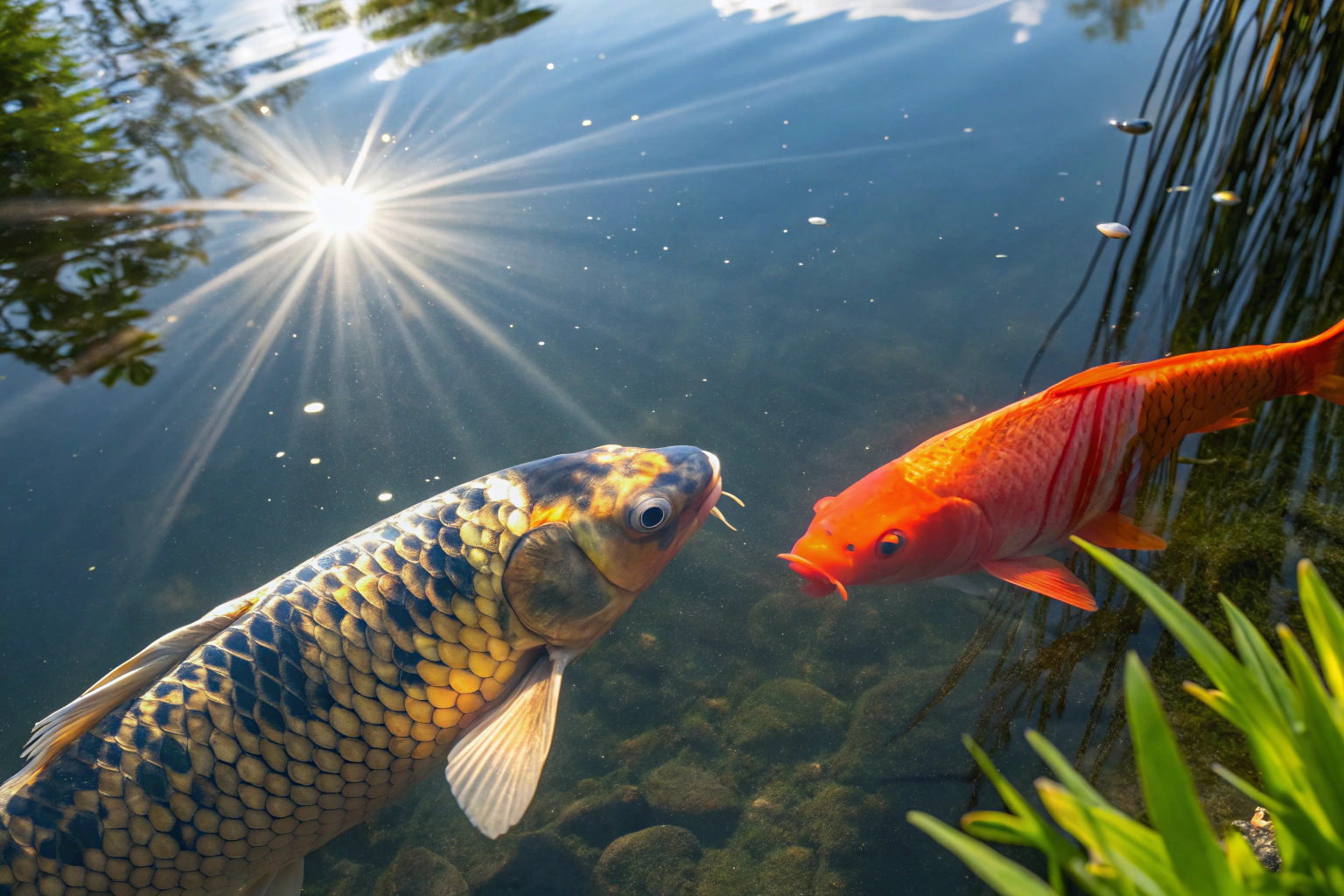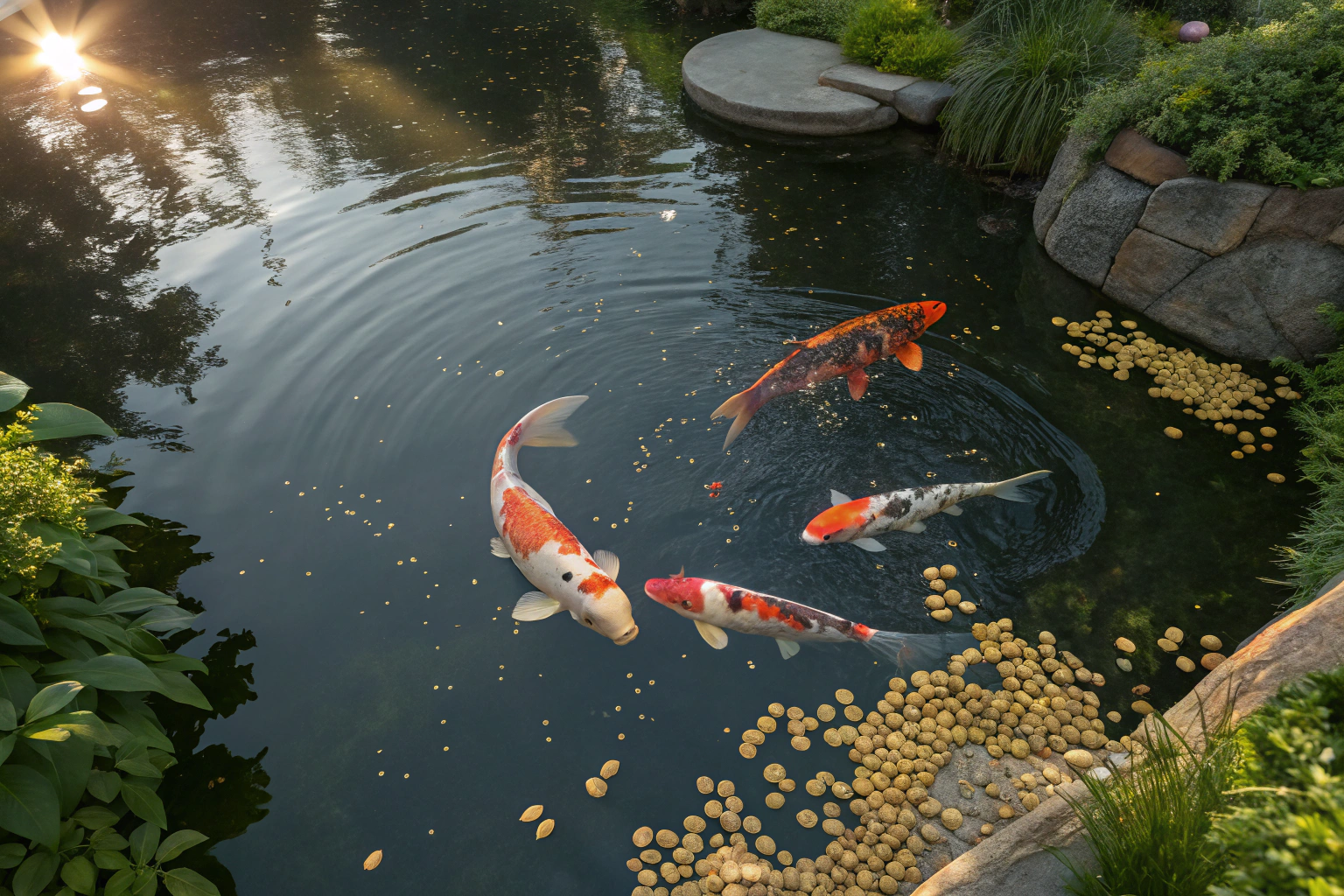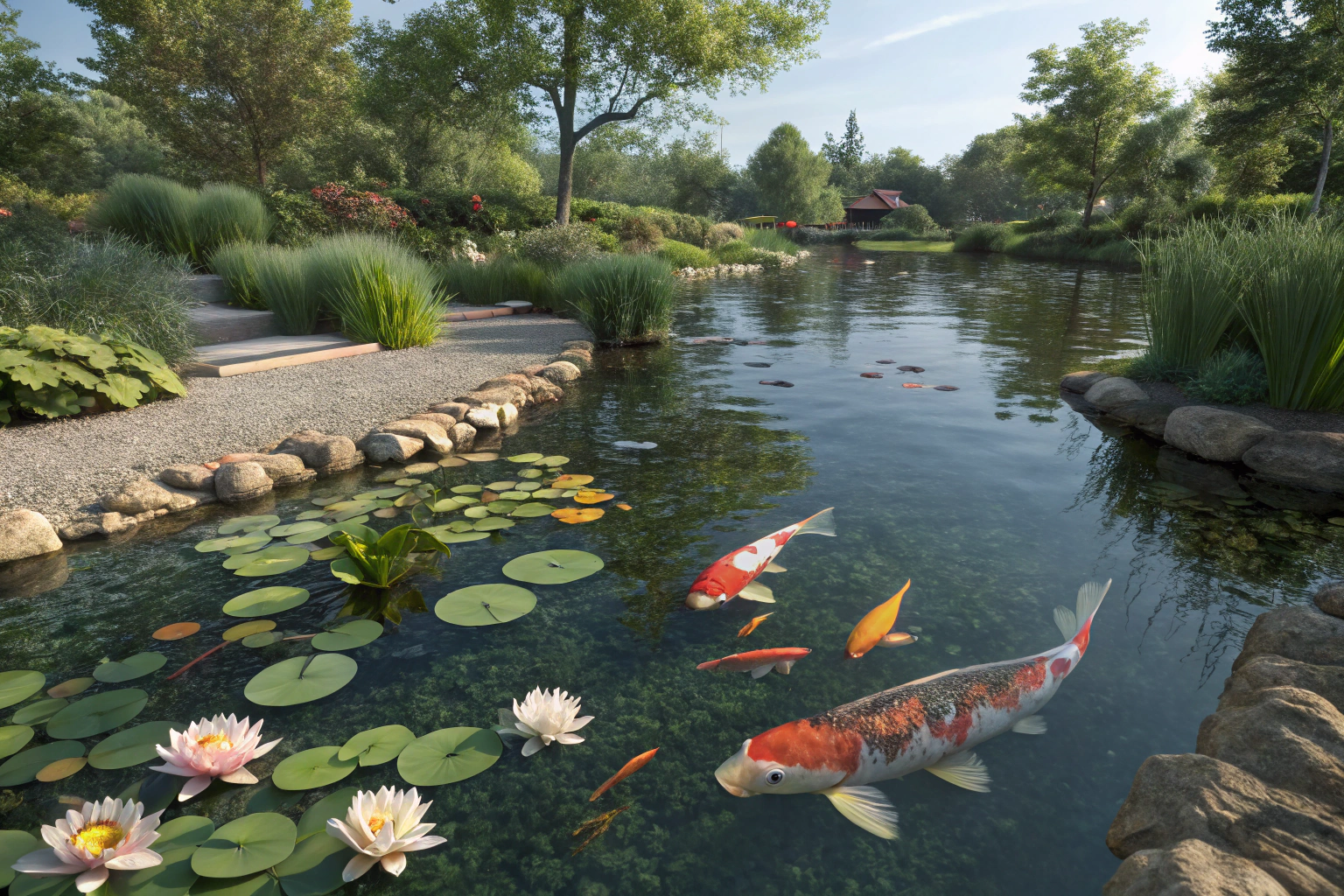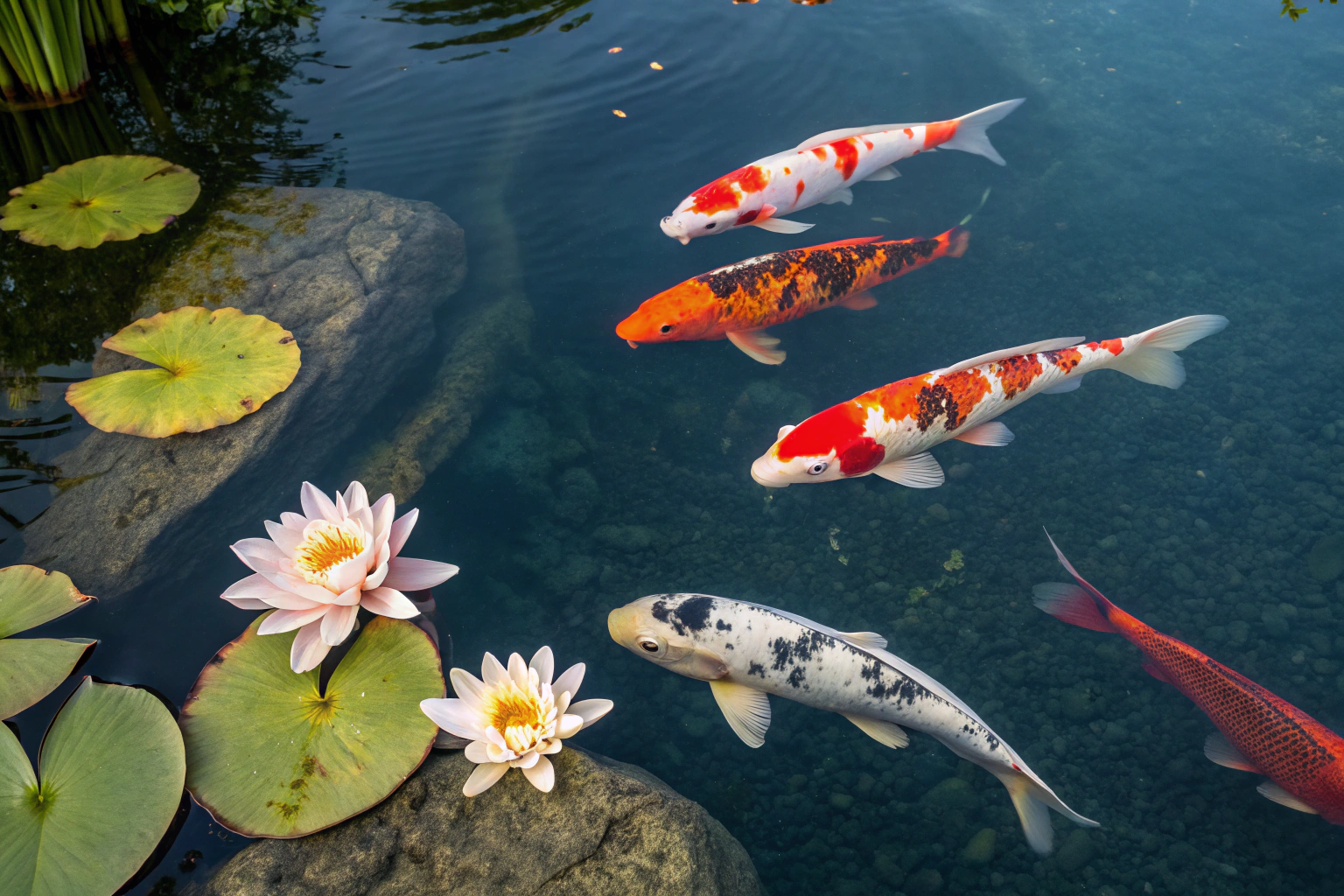Can Koi and Goldfish Live Together in the Same Pond?
This post may contain affiliate links.
The vibrant flash of a goldfish darting through the water and the serene glide of a majestic koi are iconic sights in garden ponds worldwide. As two of the most popular pond inhabitants, both belonging to the carp family, it’s a natural question for pond enthusiasts to ask: can these seemingly similar fish share the same aquatic home? The allure of a mixed pond, bustling with the distinct beauty of both koi and goldfish, is undeniable. However, while they share common ancestry and environmental needs, successful cohabitation isn’t always straightforward. It requires careful consideration of their differences, specific needs, and the environment provided. This article delves into the complexities of keeping koi and goldfish together, exploring the factors that determine compatibility and offering guidance for creating a harmonious shared pond ecosystem.

Shared Heritage: Understanding the Similarities
At first glance, koi (Cyprinus rubrofuscus “koi”) and goldfish (Carassius auratus) share several fundamental similarities that might suggest easy compatibility. Both are members of the Cyprinidae family, commonly known as the carp family, originating from East Asia. This shared ancestry means they possess comparable physiological traits adapted to freshwater environments. Both are considered cold-water fish, capable of tolerating a relatively wide range of temperatures, including the cooler conditions found in outdoor ponds throughout many temperate climates. They can even enter a state of semi-dormancy or torpor during winter when water temperatures drop significantly, reducing their metabolic rate and need for food. Furthermore, both species are generally omnivorous, feeding on insects, algae, plant matter, and commercially prepared fish foods. Their basic requirements for water quality, while having some specific nuances, overlap considerably, particularly regarding the need for well-oxygenated, clean water free from high levels of ammonia and nitrite.
Key Distinctions: Recognizing the Differences
Despite their shared lineage, several crucial differences distinguish koi from goldfish, impacting their care requirements and potential compatibility. Understanding these distinctions is vital for anyone considering housing them together. Perhaps the most apparent difference is size. While pond goldfish can grow larger than their aquarium counterparts, often reaching over a foot long in ideal conditions, koi are significantly larger fish. Adult koi commonly range from two to three feet in length, with some varieties growing even larger. This size disparity has major implications for pond volume requirements and potential interactions between the species.
A clear physical marker is the presence of barbels – small, whisker-like appendages near the mouth. Koi possess these barbels, which function as sensory organs aiding in foraging for food along the pond bottom. Goldfish lack barbels entirely. Body shape also differs; koi typically have a more robust, torpedo-like shape, built for powerful swimming. Goldfish shapes vary widely, from the streamlined bodies of Comets and Shubunkins (which are better suited for cohabitation with koi) to the rounded, often encumbered forms of fancy varieties like Orandas or Ryukins, which are poor swimmers and more vulnerable.
Lifespan is another differentiator, with koi generally living much longer than goldfish, often reaching several decades compared to the 10-15 year average lifespan of well-cared-for pond goldfish. Temperamentally, koi are often more active and can exhibit more boisterous, competitive behavior, particularly during feeding times. This energy can sometimes translate into unintentional bullying or out-competing smaller or slower goldfish for food. Finally, while both species reproduce readily in pond environments, potential hybridization exists, though offspring are typically sterile and may not exhibit the desirable traits of either parent species.

Critical Factors for Cohabitation
Successfully keeping koi and goldfish together hinges on carefully managing several key factors. Overlooking any of these can lead to stress, illness, or even mortality for one or both species.
Pond Size and Stocking Density: This is arguably the most critical factor. Koi require significantly more space than goldfish due to their larger size and higher activity levels. Overcrowding is a common mistake that leads to poor water quality, increased stress, heightened aggression, and greater susceptibility to disease. As highlighted by pond specialists like The Pond Guy, a general guideline is often cited, suggesting at least 200 gallons of water per 1-2 koi or 2-3 goldfish. However, aiming for even more generous spacing, perhaps 1,000 gallons for the first mature koi and 100-200 gallons for each additional fish (koi or goldfish), is highly recommended, especially in a mixed pond. Remember, koi can grow to be several feet long, and adequate swimming room is essential for their well-being. A larger volume of water also provides a more stable environment, buffering changes in temperature and water chemistry.
Temperament and Fish Selection: While generally peaceful, koi can be boisterous, especially during feeding. Their size and energy can inadvertently harm smaller, slower-moving goldfish. Fancy goldfish varieties, with their modified body shapes, long fins, or impaired vision (like Bubble Eyes or Celestials), are particularly vulnerable and generally unsuitable companions for koi. They simply cannot compete for food or escape the sometimes-rough interactions. If choosing goldfish for a koi pond, opt for hardy, single-tailed varieties like Comets, Shubunkins, or common goldfish. As noted by breeders like Kloubec Koi Farm, these types are more streamlined, faster swimmers, and better equipped to share space with active koi. Even then, maintaining similar sizes between the koi and goldfish is advisable to minimize the risk of the koi viewing smaller goldfish as potential food.
Dietary Needs and Feeding Strategy: Koi and goldfish have similar omnivorous diets, but koi typically benefit from a higher protein content for optimal growth and color, especially during warmer months. While many quality pond fish foods are formulated to meet the basic needs of both, competition during feeding is a major concern. Koi are notoriously vigorous eaters and can easily consume the majority of the food before slower goldfish get their share. To mitigate this, employ strategic feeding methods. Spreading the food across different areas of the pond simultaneously can help. Some pond keepers feed floating pellets for koi and sinking pellets for goldfish, or feed at opposite ends of the pond. Careful observation during feeding times is crucial to ensure all fish are receiving adequate nutrition.
Water Quality and Filtration: Both koi and goldfish produce significant waste, but larger koi produce substantially more ammonia. Maintaining pristine water quality is paramount in a mixed pond. This necessitates a robust filtration system, including mechanical filtration to remove solid waste and biological filtration to convert harmful ammonia and nitrite into less toxic nitrate. The filtration system must be sized appropriately for the pond volume and the high bioload generated by koi. Regular water changes (e.g., 10-25% weekly or bi-weekly) are essential to dilute accumulated nitrates and replenish minerals. Consistent water testing for pH (ideally stable between 7.0 and 7.8), ammonia, nitrite, and nitrate is non-negotiable. Adequate aeration, through waterfalls, fountains, or air stones, is also vital to maintain high dissolved oxygen levels, especially in warmer weather or heavily stocked ponds.
Disease Prevention and Health Management: Koi and goldfish are susceptible to many of the same parasites and bacterial infections. Introducing new fish without proper quarantine is a major risk, potentially bringing diseases like Ich (White Spot Disease), flukes, or bacterial infections into the established pond community. A strict quarantine protocol of at least 4-6 weeks for all new arrivals is crucial. Furthermore, specific diseases like Koi Herpesvirus (KHV) can be devastating. While primarily associated with koi, goldfish can sometimes act as carriers. Maintaining excellent water quality, avoiding overcrowding, and minimizing stress are the best defenses against disease outbreaks. Should treatment become necessary, be aware that some medications safe for one species might harm the other, requiring careful selection or temporary separation.

Best Practices for a Harmonious Mixed Pond
Creating a thriving pond where both koi and goldfish coexist peacefully requires proactive management and adherence to best practices. Beyond understanding the core compatibility factors, implementing these strategies will significantly increase the chances of success:
- Prioritize Space: Always err on the side of caution with pond size. Provide ample volume and surface area, exceeding minimum recommendations if possible. A larger pond offers more stable water parameters and reduces stress from crowding.
- Choose Companions Wisely: Select only robust, single-tailed goldfish varieties (Comets, Shubunkins) that are similar in size to the koi, especially when the koi are young. Avoid fancy goldfish entirely.
- Quarantine Rigorously: Never introduce new fish (koi or goldfish) directly into the main pond. Implement a strict quarantine period of 4-6 weeks in a separate system to monitor for and treat any potential diseases or parasites.
- Strategic Feeding: Develop a feeding routine that ensures all fish receive adequate nutrition. Distribute food widely, consider using both floating and sinking pellets, and observe interactions to prevent koi from monopolizing resources.
- Invest in Filtration and Aeration: Do not skimp on filtration. Install a high-quality biological and mechanical filter system rated for a higher bioload than your initial stocking levels anticipate. Ensure robust aeration, especially during warm weather.
- Maintain Water Quality Diligently: Conduct regular water tests (pH, ammonia, nitrite, nitrate) and perform routine partial water changes. Address any water quality issues promptly.
- Provide Shelter: Include aquatic plants (like water lilies or hornwort, ensuring they are safe for fish consumption or protected) and structures like fish caves or overhangs. These provide hiding places for goldfish, reducing stress and offering refuge from overly boisterous koi.
- Monitor Fish Health and Behavior: Regularly observe your fish for any signs of illness, injury, or stress (e.g., clamped fins, lethargy, sores, gasping at the surface). Pay attention to interactions, watching for signs of bullying or excessive competition.
- Plan for Growth: Remember that both koi and goldfish will grow. Factor their adult sizes into your initial stocking plan to avoid future overcrowding issues.
By diligently applying these practices, pond keepers can foster an environment where the distinct beauty of both koi and goldfish can be enjoyed side-by-side.

Conclusion: A Balanced Ecosystem
In conclusion, the answer to whether koi and goldfish can live together in the same pond is a conditional “yes.” While they share common ancestry and can adapt to similar environments, their differences in size, temperament, and specific needs necessitate careful planning and diligent management. Success hinges on providing ample space, selecting compatible goldfish types (specifically hardy, single-tailed varieties), ensuring robust filtration and pristine water quality, and implementing strategic feeding practices to prevent competition. Overlooking factors like pond volume, stocking density, or the vulnerability of fancy goldfish can quickly lead to an unbalanced and unhealthy environment. However, for the dedicated pond keeper willing to invest the effort in creating and maintaining the right conditions, a mixed pond featuring both the graceful elegance of koi and the cheerful vibrancy of goldfish can be a rewarding and beautiful aquatic display. It requires a commitment to understanding the needs of both species and actively managing their shared environment to ensure long-term health and harmony.
